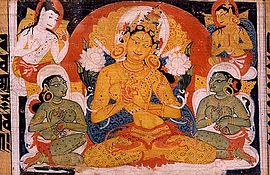Aṣṭasāhasrikā prajñāpāramitā
| Prajnaparamita sutras |
|---|
| Selected short sutras |
| Medium length sutras |
|
| Long sutras |
|
Aṣṭasāhasrikā prajñāpāramitā. (T. Sher phyin brgyad stong pa; C. Xiaopin bore jing; J. Shōbon hannyakyō; K. Sop’um panya kyŏng 小品般若經). In Sanskrit, “Perfection of Wisdom in Eight Thousand Lines.”[1][2] This text and the Ratnaguṇasaṃcayagāthā (a.k.a. "Verse Summary") are generally considered to be the earliest of the Prajnaparamita sutras.[1][3]
The Princeton Dictionary states:
- The Aṣṭa, as it is often referred to in the literature, seems to have gradually developed over a period of about two hundred years, from the first century BCE to the first century CE. [...] The Aṣṭa, together with its verse summary, the Ratnaguṇasaṃcayagāthā, probably represents the earliest stratum of the prajñāpāramitā literature; scholars believe that this core scripture was subsequently expanded between the second and fourth centuries CE into other massive Prajñāpāramitā scriptures in as many as 100,000 lines (the Śatasāhasrikāprajñāpāramitā). By about 500 CE, the Aṣṭa’s basic ideas had been abbreviated into shorter condensed statements, such as the widely read, 300-verse Vajracchedikā Prajñāpāramitā Sūtra (“Diamond Sūtra”).[1]
Summary
84000 translation group states:
- This sūtra takes the form of a series of dialogues between the Buddha Śākyamuni, Subhūti, Śāriputra, and others such as Indra, the king of gods, and a Goddess of the Ganges, and as well as setting out the teachings on emptiness as such it describes the path and practices that a bodhisattva should take to integrate this understanding of phenomena and finally realize it. A special feature of this particular sūtra are the inspirational narratives of Sadāprarudita and his quest for the teachings on the Perfection of Wisdom from the Bodhisattva Dharmodgata, contained in the final three chapters.[2]
Translations
Chinese
Some of the earliest recensions were translated into Chinese during the Han dynasty.[1]
Tibetan
In the Tibetan Canon, the text is numbered Toh 12 in the Dege edition of the Kangyur, and consists of 32 chapters.
In the Tibetan tradition, this text is counted among the 'six mother scriptures' of the Prajnaparamita.
English
- Edward Conze, Perfection of Wisdom in 8,000 Lines and its Verse Summary, (1958)
- 84000, The Perfection of Wisdom in Eight Thousand Lines - translation in progress[2]
Commentaries
Indian
- Haribhadra
- Abhisamayālaṃkārālokā (Light on the Ornament) - a commentary that correlates the verses of the Abhisamayālaṃkāra with corresponding sections in the Aṣṭasāhasrikā prajñāpāramitā
- Abhisamayālaṃkāravivṛti (a.k.a. Sphuṭārthā) - a summary of the Abhisamayālaṃkārālokā
- Ratnakarashanti, Supreme Essence (Sarottama)
- Abhayakaragupta, Moonlight of Points (Marmakaumudi)
Outline
See:
 Aṣṭasāhasrikā Prajñāpāramitā Sūtra#Outline, Wikipedia
Aṣṭasāhasrikā Prajñāpāramitā Sūtra#Outline, Wikipedia
Quotations
སེམས་ལ་སེམས་མ་མཆིས་ཏེ། །
སེམས་ཀྱི་རང་བཞིན་ནི་འོད་གསལ་བའོ། །
The mind is devoid of mind,
For the nature of mind is clear light.
Notes
- ↑ 1.0 1.1 1.2 1.3 Robert E. Buswell Jr., Donald S. Lopez Jr., The Princeton Dictionary of Buddhism (Princeton: 2014), s.v. Aṣṭasāhasrikāprajñāpāramitā
- ↑ 2.0 2.1 2.2
 The Perfection of Wisdom in Eight Thousand Lines
The Perfection of Wisdom in Eight Thousand Lines
- ↑ Skilton 1997, Chapter 12.
Further reading
 Aṣṭasāhasrikā Prajñāpāramitā Sūtra, Wikipedia
Aṣṭasāhasrikā Prajñāpāramitā Sūtra, Wikipedia- Edward Conze, The Prajñāpāramitā Literature (1960)
 Perfection of Wisdom Sutra in Eight Thousand Lines, Rigpa Shedra Wiki
Perfection of Wisdom Sutra in Eight Thousand Lines, Rigpa Shedra Wiki
